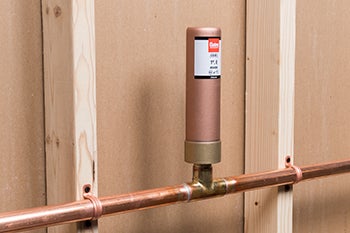The washing machine stops filling, and you immediately hear a loud BANG inside your wall. What was that noise? And how do you prevent it from happening again?
This noise can be alarming, but luckily it is not something to worry about immediately.
The banging noise you heard is typically caused by your water pipes, and it is one of a few sounds that can come from your plumbing.
While a water hammer could be the explanation, starting with a survey of all your visible water lines can help you fix or rule out any other causes. Before you get a plumber involved, take a look at how you can troubleshoot the issue:
How to stop pipes from banging?
To discover the cause and possibly stop the banging noise from happening again, you should quickly assess your visible water lines and plumbing connections. This will determine whether you will need to call a professional.

● Check all visible water lines. Start gently pushing and pulling on any visible pipes to see if they move. If you find any length of pipe over 16 inches that moves with a light push, mark it with a piece of tape to come back to after you've finished checking everything.
Oatey Tip: To prevent the pipes from touching the surrounding building materials, water lines should have support every 16 inches and at every change of direction.
● Locate any internal or external holes. When the water pipes are gently pushed, see if they touch the sides in any direction. Any water line that passes through a hole should have support installed, or expandable foam applied. That will keep pests and insects from traveling through a hole.
Oatey Tip: On any large holes in wood studs, a combination of a j-hook and pipe insulation clamps can cushion them against any wood or drywall.
● Check your valves. Make sure all valves and faucets are fully open. Partially opened valves can cause noise from the valve port not being fully open. Water pressure being too high or too low can cause issues also. Seek professional help if you are experiencing a low water flow rate.
Oatey Tip: Your water pressure should be between 60 to 80 pounds per square inch (psi). You may need to call a professional to regulate pressure properly or replace plumbing segments that have become blocked.
● Check your water heater. Built-up sediment in your water heater could be a reason for the banging noises. This is caused by the steam bubbles escaping from the accumulated sediment at the bottom of the tank.
Oatey Tip: Flush your water heater using Hercules Haymaker® Tankless Water Heater Descaler or Hercules® Sludgehammer™ System Restorer & Noise Reducer to dissolve the deposits that restrict water flow.
Once you've assessed your pipes and fixed any other issues, yet the sound continues, what you may be hearing is hydraulic shock – more commonly known as a water hammer.
What is a water hammer?

Water hammering is the shaking, rattling, or banging you hear from your water-distribution pipes when the water is shut off abruptly. Water hammers occur when the flow of water stops and the kinetic energy resonates through the pipes, causing waves inside and creating a hammering sound.
It could sound like a loud bang, a series of bangs or shuddering, and can occur anywhere water shuts off quickly, such as at a washing machine, dishwasher or toilet. While annoying, the water hammer has likely not caused any damage to your pipes. However, if left untreated, water hammer can cause issues.
How to fix and prevent water hammer

The easiest way to prevent and fix a water hammer is to create a space before the outlet filled with gas or air that can absorb the pressure. In older homes, this was originally accomplished by creating an air chamber, a piece of capped-off vertical pipe near the outlet.
Air chambers often end up filled with water from the pressure changes and no longer work to absorb the shock. The only solution is to drain the entire system to "recharge" the air chamber. A more practical and enduring solution is using water hammer arrestors.
Water hammer arrestors, like Oatey's Quiet Pipes, create space for the water to move when there is a shock, but features a piston design in a sealed pressurized chamber to prevent water from remaining in the arrestor. This design also allows for the water hammer arrestors to be installed at any angle and still absorb shock. The internal piston creates a watertight/airtight seal to avoid any air loss and prevent the chamber from filling with water. Quiet Pipes come in a range of connection types including MIP, CPVC, PEX, and more.
How to install a hammer arrestor
Installing water hammer arrestors can be done at any time, although during construction is preferred to prevent water hammer and protect your plumbing systems. For residential installations that are made right at the connection point, here is how to install a hammer arrestor:
STEP 1: Turn the water off and remove the connections or hoses.
STEP 2: Inspect the condition of the connection or hose for any leaks and replace joints that have become damaged. Clean the screen of any debris.
STEP 3: Choose the correct hammer arrestor for the application. Hand-tighten the arrestor to the hot and cold valve. They may be installed in any direction.
STEP 4: Further tighten the hammer arrestor with a wrench. Make sure not to over-tighten.
STEP 5: Reconnect the hoses. Turn the water back on and test.
Most banging pipes can be fixed or prevented by quickly assessing your plumbing, securing any loose pipes, and installing a hammer arrestor. Protect your plumbing appliances and fixtures from the effects of water hammer and help extend the life of your valves. Be sure to contact a professional to assist in identifying the issue or installation.